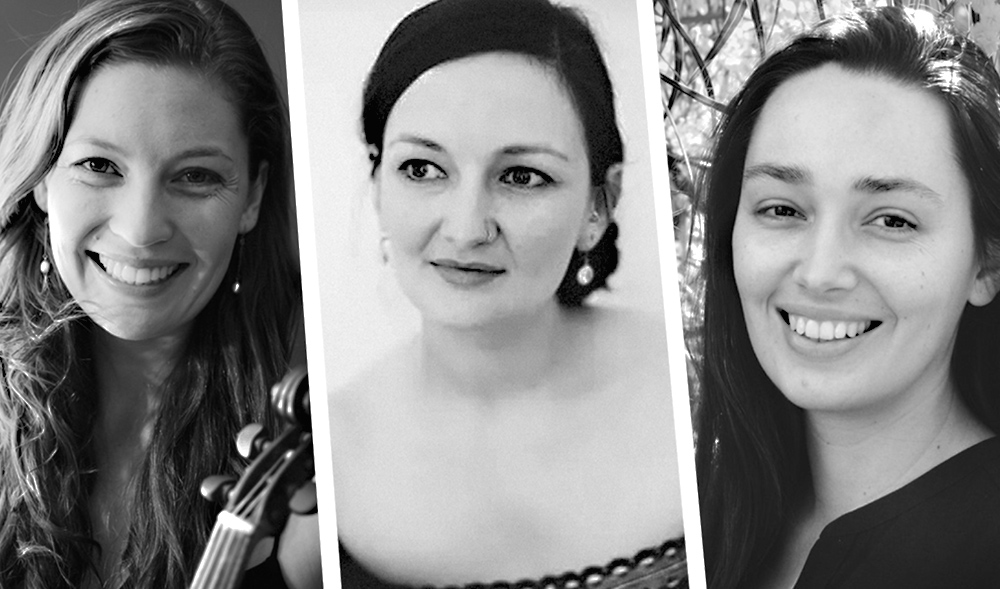Illustrious and incomparable: The extraordinary woman of the Baroque
Elder Hall June 18th 2023
The scene on entering the inviting Elder Hall on a cold Winter afternoon promised a fascinating concert. The harpsichord with its beautiful painted lid by the artist Bill Bright and a small elegant Baroque harp were centre stage. But flanking these were 2 white screens – very non-Baroque!
They came alive during the first piece with blue and white wisps floating around; appropriate colours for the ‘Ave Maria’ aria. Composed by Chiara Margarita Cozzolani around 1640, it is a florid hymn of praise “Hail Mary, O Mary mother of God”. The music mirrors the ecstatic words with a free, florid, arrythmic melody confidently sung by Kate McFarlane. The delicate harp & theorbo accompaniment was beautifully played by Hannah Lane & Nicholas Pollock.
The Sonata that followed also included violins, cello & harpsichord: the contrast of bowed melodic strings and plucked basso continuo was very effective. The texture was transparent so the interweaving of the violins & cello was highlighted. The ensemble of all instruments was exemplary, and the violinists Simone Slattery & Ben Dollman and cellist Thomas Marlin intertwined their improvisatorial melodies as one.
Three of the featured Baroque composers were members of religious orders and this facilitated their musical careers. Their environment provided support, atmosphere and encouragement and performance of their works was guaranteed at the church services. Isabella Leonarda also composed instrumental music and was herself a violinist. The aria “Volo Jesum” began so delicately with only harp accompaniment and then the 2 violins embellished the solo voice and the harpsichord, discreetly played by Katrina Brown, added substance to the basso continuo. It was a masterly compositional technique. The changing rhythms and pulse flowed seamlessly and the tension was maintained to the end.
The following Sinfonia by the same composer featured similar characteristics with the whole Baroque Orchestra participating. The lower notes of the violone precisely played by Robert Nairn added another dimension and the recorders high, light tones expertly added by Brendan O’Donnell and Jayne Varnish gave a new tone colour. A very pleasing piece.
Georgina Bowden’s ‘The Sky Undone’ was a contrast using the same tone colours. Instead of melody and improvisation we had layers of sound linked to the images on screen – moving coloured shapes. Inspired by Caccini’s words “day in the middle of night, see sky opening, hear the sounds of angelic chorus” it had atmosphere of wonder. The soprano hovered and wafted and the strings echoed her as did the images on the screens. Effective and compelling.
After the interval Brendan O’Donnell played a Flute Sonata by Princess Anna Amalia of Prussia. She was the sister of Frederick 2nd, an accomplished flautist and friend of Quantz & J.S.Bach. He taught his sister the flute and encouraged her compositions. She, too, flourished in a convent and composed not only religious works but also instrumental. This Sonata was accompanied by harpsichord and theorbo and the cello which assumed a duet role in the last movement adding its interjections to the solo treble recorder. Following that, Kate McFarlane sang a poignant aria by Barbara Strozzi, an accomplished singer herself; it had a perfect ending, evaporating into thin air.
Elisabeth Claude Jacquet de la Guerre was a court musician for Louis 14th at a very young age. Famous in her day she was compared to Marais and Lalande. Her Trio Sonata for 2 violins and cello was played with full awareness of the counterpoint and blending of harmonies, perfectly timed and intertwined.
The final work also by de la Guerre featured selections from her stage work written for the king, ‘Cephale & Procris’.
Two lyrical arias were interspersed by orchestral movements with the whole ensemble displaying their wonderful sonorous sound, excellent ensemble skills and lively rhythms. The violone pizzicato adding strength to the other plucked instruments and the recorders lending an airiness and brilliance to the group. A delightful concert with interesting repertoire. The excellent program notes by Graham Strahle helped the audience to understand the music and the period as did the telling portraits of the composers. Despite all works being composed between about 1610 and 1790 by female composers (apart from Georgina Bowden’s work, of course!) there was great diversity and contrast; another successful performance by Adelaide Baroque.

